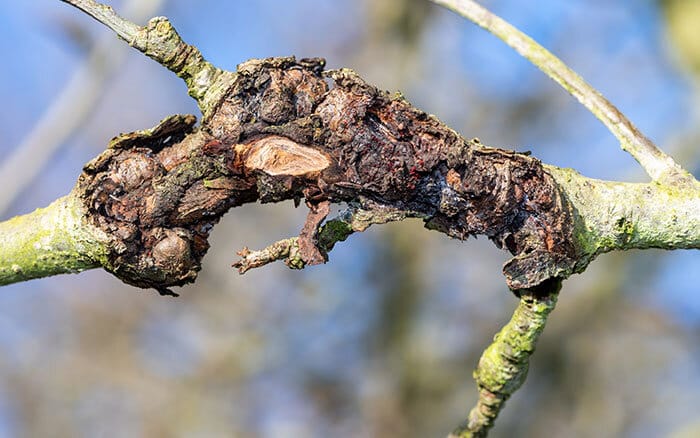Neonectria ditissima is more commonly known as apple canker. It’s a fungal disease that leads to parts of the bark looking sunken and disfigured. So how do you spot apple tree canker and treat it in the garden?
How to spot apple canker
It’s usually spring when apple canker appears. They can either look like oval areas of sunken or dead bark, but it can look slightly different depending on the part of the plant that has been affected.
Fruit that is growing can fall victim to the disease and can rot and drop. Although it most commonly impacts branches. Smaller branches can become infected, and the bark can crumble off.
On the other hand, it can be more noticeable on larger branches because rings appear in a concentric fashion, showing the spread of the infection. As the cankers get older, the bark peels away, leaving the wood underneath exposed.
The wood can look dark, rough, and cracked, and over time parts can turn white – this is the decay fungi.

What is it?
Canker is a fungal disease that is more of a worry in heavy and wet soils or overly acidic sites. Therefore, it’s important to keep drainage at an optimum and adding lime as a supplement to increase the soil pH to decrease the acidity levels.
There are more factors that can cause apple cankers, such as injury from extreme weather, hail, or pruning cuts that have become infected.
The infection spreads most commonly by water spores in spring and summer, as well as by airborne spores in winter to spring.

How to stop or treat canker
The disease can impact apples, pears, and trees in the Sorbus family. So, if you’ve spotted canker on your trees, cut off the small branches that are impacted. With larger branches, cut out as much as possible. Seal with a wound paint that will decrease the likelihood of it becoming reinfected and leading to more issues.
If canker seems to be a common problem, you may need to consider the nutrition and conditions that the tree has access to.
Canker fungus is a lover of nitrogen and high humidity levels, so don’t apply nitrogen from autumn to late winter. Instead wait until spring to apply nitrogen.


Leave A Comment